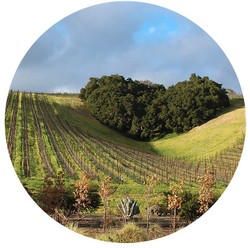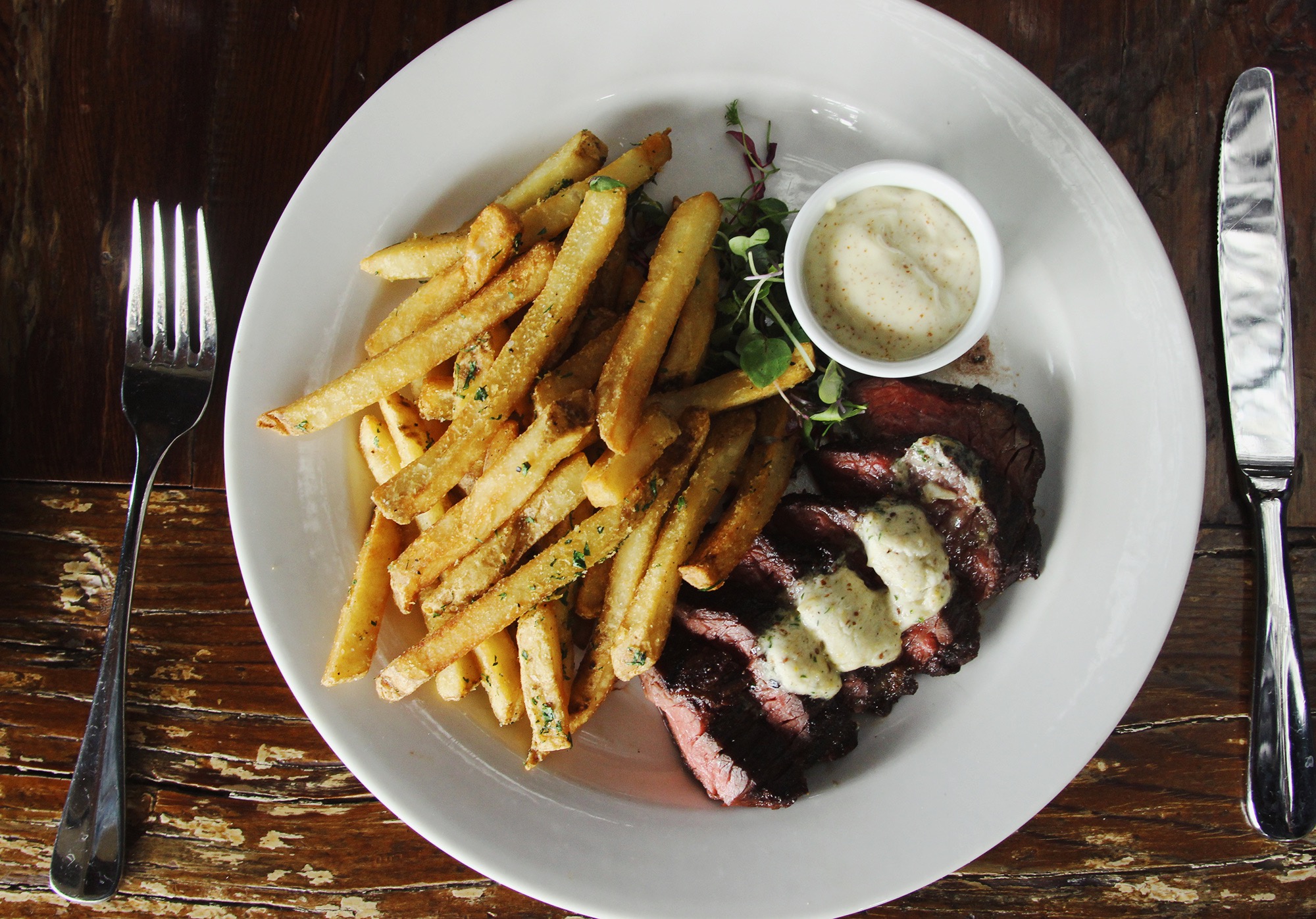Springtime Recipes
With the release of our latest set of 2017 wines, we wanted to give you some ideas of what to enjoy them with. Executive Chef Jacob Burrell has written up three different recipes, adapted for you to cook at home. His advice for all you Chefs at home:
"As with all recipes, read and reread in advance until understood and internalized. Common sense trumps all; follow your heart. Begin with an end in mind; imagining the final result will help you make intentional choices to bring your vision to life."
- 1. Wedding Soup + Carménère
- 2. Fish with citrus butter sauce + Silhouette du Coeur
- 3. Caramelized red onion butter + Cabernet Sauvignon or Fog Catcher

Springtime at Heart Hill
Wedding Soup (minestra maritata)
This old world traditional soup has different roots than the canned version we all know. Originally, this pork and foraged wild greens collaboration was made after pig slaughters. The “marriage” referred in the title isn’t about matrimony - it’s about the union of pork and greens and water to create something greater than its parts.
What to drink: Our 2017 Reserve Carmenere (available now, $65) adds an additional layer to the union of pork and green flavors. Revered for its natural herbaceous flavor, the wine has enough palate weight and acidity to pair well with this soup.
Recipe for the home cook follows:
1 lb. assorted pork (bones, sausages, cubed shoulder, shank, etc)
2-3 sliced onions
Handful of garlic cloves, peeled and gently smashed
¼ cup of olive oil
1 lb. roughly chopped hearty greens (chard, kale, nettles, borage, cabbage, etc)
4 cups water (or half quality chicken stock/half water)
1 TBSP. of dried/fresh chili (optional)
Season pork with salt in advance (from 1hr to overnight).
In a large pan, heat olive oil and brown off pork on all sides. Remove from pan, draining off excessive fat. Reduce heat and add onions and garlic. Season with salt as you go, adding chili if desired. Cover and sweat over low heat until tender and translucent, stirring periodically. Once cooked through (about 10 mins) add the greens, season and stir. Cook for a few minutes to wilt the greens down. Add pork and water/broth.
Bring to a simmer and place in 325F oven. Depending upon your cuts, pork could be ready in 1.5 – 2 hours. Check every 30 minutes, stirring and tasting and seasoning (pork will be cooked through and safe to taste after first 30 minutes). If you’d like some “fresh” greens, save some and add into pan for last 10-20 minutes of cooking.
Serve with fresh cracked pepper, drizzle of good olive oil and crusty bread.
A note from the Chef: Ideally, you’d make a week’s worth of soup - so, take your time, give it care and attention throughout the process and you’ll be rewarded with an afternoon of cooking alchemy and a week’s worth of nourishment.
Here, much like in the restaurant, we like to begin on the stove and then finish in the oven. We feel like we have better control over the heat, reduction of moisture and concentration of flavors. If you don’t have an oven pan of size, a stock pot on the stove works.
Weekday Meals
Enjoy as a soup/stew
With poached eggs for breakfast
Over polenta or rice
Tossed with pasta
Fish with citrus butter sauce
We ran a dish for brunch a few months back: halibut cheeks, sauce maltaise and broccoli. When we tasted this year’s Silhouette du Coeur, our minds naturally went back to that. Sauce maltaise is in the hollandaise family tree; you take that base and work in blood orange zest and juice. Classically, it’s paired with asparagus but works well with other green vegetables and seafood. We’re going to take those flavors and adapt them to braising fish fillets.
What to drink: Our 2017 Silhouette du Coeur (available now, $30) has a rare combination of roundness on the palate and high acidity on the finish.It’s a delight to serve a glass alongside dishes with a rich seafood base and it’s (very very slight) sweetness plays nicely with the blood orange and ginger flavors in the sauce.
Recipe for the home cook follows:
1 lb. mild fresh white fish fillets, shrimp or scallops
1x sliced shallot (or 1/4x sliced onion)
1x garlic clove, lightly smashed
1x tiny piece of ginger, lightly smashed
1x blood orange split into: a few strips of zest, half juiced and half cut into segments
2T olive oil
1 cup white wine
1/4 cup quality light chicken/vegetable stock or clam juice
4T butter
1 head broccoli, including stem peeled and cut into wedges
A couple drops of fresh lemon juice
Preheat oven to 350F. Seafood benefits from being seasoned 20 minutes to an hour in advance to help release some of the glutamates (meatiness/umami). Salting in advance will also firm up the flesh a bit.
In an ovenproof pan, heat olive oil. Carefully place seasoned seafood in pan and lightly color both sides (about 30 seconds per side). Add garlic, ginger, wine, zest and water/stock. Bring to a simmer and then transfer pan to oven. Finish in oven until fish is cooked through to desired doneness. (1” thick fish will be cooked through in about 10 minutes - use this as your guide).
While your fish is finishing, fill a pot (that has a lid) with water to cover the bottom. Season water with salt and steam broccoli to desired doneness. When finished, remove broccoli from pot and reserve.
When ready, remove fish fillets from the oven and reserve. Place pan on stovetop at medium heat. Check for seasoning of your broth, perhaps adding a pinch of salt at this point. Add butter and orange juice and reduce until saucy consistency (about 1-2 min). Add in orange segments and fish fillets, tossing to coat. Check seasoning. Plate and serve with the steamed broccoli.
A note from the Chef: This recipe is a basic pan sauce structure. Protein of your choice + aromatics + deglazing the pan with liquid (wine, water or stock). This type of cooking produces a meat/fish and sauce relatively quickly and can be endlessly adapted. You can use stock/juice to add more depth, finish the sauce with some butter/cream/olive oil or add last minute flavorings (mustard, herbs, capers, citrus are a few that come to mind). It also works great with chicken thighs, pork cutlets, minute steaks….. choose your own adventure.
To achieve more of a “hollandaise” consistency and flavor, separate 1x egg yolk and reserve. Once fish comes out of oven and is reserved from pan, place yolk in coffee mug or other small vessel. Spoon in a couple ounces of hot sauce and beat with a whisk/fork to acclimatize the yolk without cooking it. Once homogenous, pour back into rest of sauce, stir to mix and finish like above - keeping heat at a simmer and stirring continuously. Here, we’re using the yolk to thicken the sauce versus reduction (above).
Caramelized red onion butter
You’re only as good as your condiments. This recipe involves making a compound butter. Flavoring butter in advance gives us a chance to perfume its fat and allows for a quick and easy to use condiment. A chance to add maximal flavor with minimal effort.
What to drink: A bottle of any of our Cabernet Sauvignons (like our new 2017 Cab $45) or Fog Catcher would be a great match for this butter when served on top of a Grilled New York Strip Steak. In fact we use a similar preparation on our steak frites which we’re currently serving with 2016 Fog Catcher ($100) We’re using the same philosophy here - the wine is the sauce. Cook well, season simply and adequately, and let the food and wine play off of each other as you enjoy.
Recipe for the home cook follows:
1 lb. quality butter
2T olive oil
1 lb. sliced red onions
3x garlic clove, minced
1T mustard (whole grain or dijon… just not yellow hot dog mustard)
1 tsp sea salt
1 tsp fresh cracked black pepper
1 T chopped parsley (optional)
Temper butter at room temperature until soft, 30-60 minutes. In a large surfaced pan or skillet, pour in oil and onions and season with salt. Turn heat to medium low: starting “cold” allows more time to slowly cook onions and then caramelize their sugars. Seasoning early with salt pulls out a little moisture and slows the caramelization. In the restaurant, we would cover the pan too to slow things down even more- using condensation as an ally.
Stir onions periodically, adding a touch more oil if needed (if onions start to stick and pan sizzles get a little louder). Once onions are soft and start to color (10-15min) add in the garlic. Add a pinch more salt (“food in the pan, salt in the pan” cooking school mantra for season as you go) and turn down the heat if needed. Continue to cook for 10-15 minutes longer until onions completely melt and are well caramelized. We want to take the time to really coax out as much of that bitter sweet oniony goodness as we can. Once you’re happy with your onions, set aside to cool to room temperature.
In a mixing bowl (by hand or machine) combine the soft butter, onions and garlic, mustard, and seasonings. Mix well until homogenous.
Lay out a sheet of parchment or foil. Spoon out butter mixture onto wrapper and proceed to roll into a log. Seal up and store in refrigerator. For longer storage, slice the chilled log of butter and place in freezer bag and freeze- pulling out a pieces as needed.
A note from the Chef: For the most part, we’re all working with the same ingredients…. carrots, onions, beef, pasta, etc. How you choose to dress up those raw ingredients is where your personality and skill as a cook comes through - and shows what separates you from your neighbor.
Weekday meal ideas:
Grilled New York strip topped with the butter
Toss with roasted carrots or winter squash (we do this, adding little more mustard and tarragon, as a side dish)
Topping for baked potato or boiled potatoes
Toss with noodles and top with breadcrumbs and serve with pot roast
Could use to finish pan sauce for chicken, pork or fish
steak frites with a version of the butter in the above recipe
